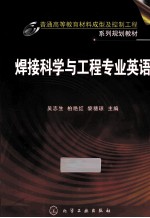图书介绍
焊接科学与工程专业英语PDF|Epub|txt|kindle电子书版本网盘下载

- 吴志生,柏艳红,黎穗琼主编 著
- 出版社: 北京:化学工业出版社
- ISBN:9787122154583
- 出版时间:2013
- 标注页数:190页
- 文件大小:39MB
- 文件页数:199页
- 主题词:焊接-英语-高等学校-教材
PDF下载
下载说明
焊接科学与工程专业英语PDF格式电子书版下载
下载的文件为RAR压缩包。需要使用解压软件进行解压得到PDF格式图书。建议使用BT下载工具Free Download Manager进行下载,简称FDM(免费,没有广告,支持多平台)。本站资源全部打包为BT种子。所以需要使用专业的BT下载软件进行下载。如BitComet qBittorrent uTorrent等BT下载工具。迅雷目前由于本站不是热门资源。不推荐使用!后期资源热门了。安装了迅雷也可以迅雷进行下载!
(文件页数 要大于 标注页数,上中下等多册电子书除外)
注意:本站所有压缩包均有解压码: 点击下载压缩包解压工具
图书目录
Chapter 1 Welding Technology Fundamental1
1.1 Modern Engineering Structural Material1
1.2 Mechanical Property of Metal Material3
1.3 Thermophysical Property of Metal Material4
1.3.1 Specific Heat4
1.3.2 Thermal Expansion5
1.3.3 ThermalConductivity5
1.3.4 Melting Point or Melting Range5
1.3.5 Thermionic Work Function6
1.4 Principal Types of Heat Treatment of Steel6
1.5 Arc Physics6
1.5.1 Stabilitv of E1ectric Arc6
1.5.2 Stability of AC Arc8
Chapter 2 Arc Welding Power Source16
2.1 Classification ofPower Source16
2.1.1 AC Power Supplies16
2.1.2 DC power supplies19
2.1.3 Inverse Source of Arc Welding20
2.2 Electrical Characteristics of Power Source21
2.2.1 Constant Voltage21
2.2.2 Constant Current21
2.2.3 Combined Constant-Current and Constant-Voltage Characteristics22
2.3 Selecting and Specifying a Power Source22
Chapter 3 Arc Welding Process25
3.1 Shielded Metal-Arc Welding25
3.2 Gas Shielded-Arc Welding27
3.2.1 Specific Advantages of Gas-shielded Arc28
3.2.2 Types of Gas-Shielded Arc Processes28
3.2.3 Gas Tungsten Arc-Tig28
3.2.4 Gas Metal Arc-Mig31
3.2.5 CO2 Welding34
3.2.6 Pulsed Arc Welding35
3.3 Submerged Arc Welding Fundamentals of the process36
3.3.1 Deffmition and general description36
3.3.2 Principles of operation37
3.4 Plasma Arc Welding38
3.4.1 Keyhole Action39
3.4.2 Arc Shaping39
3.4.3 Operating Data39
3.4.4 Applications40
3.4.5 Summary40
Chapter 4 Other Welding Methods41
4.1 Resistance Welding41
4.1.1 Introduction41
4.1.2 Resistance Spot Welding(RSW)42
4.1.3 Projection Welding44
4.1.4 Resistance Seam Welding(RSEW)45
4.1.5 Upset Butt Welding46
4.1.6 Fiash Butt Welding47
4.2 Friction Stir Welding49
4.2.1 Introduction49
4.2.2 Principles50
4.2.3 Friction Stir Tool51
4.2.4 Friction Stirring Imperfections55
4.3 Laser Beam Welding56
4.3.1 Introduction56
4.3.2 Principles58
4.3.3 Metals Welded60
4.3.4 Machines60
4.3.5 Parameters and Technology62
4.4 Electron Beam Welding63
4.4.1 Introduction63
4.4.2 Principles64
4.4.3 Variations66
4.4.4 Equirment67
4.4.5 Safety68
Chapter 5 Welding Metallurgy69
5.1 Chemical Reactions in Welding69
5.1.1 Overview69
5.1.2 Gas-Metal Reactions70
5.1.3 Slag-Metal Reactions79
5.2 Weld Metal Solidifcation85
5.2.1 Epitaxial Growth at Fusion Boundary85
5.2.2 Nonepitaxial Growth at Fusion Boundary86
5.2.3 Competitive Growth in Bulk Fusion Zone87
5.2.4 Effect of Welding Parameters on Grain Structure88
5.2.5 Weld Metal Nuc leation Mechanisms89
5.2.6 Grain Structure Control94
5.3 The Microstructure and Properties of Heat-affected Zone97
5.3.1 Welding Thermal Cycle98
5.3.2 The Microstructure Changes in the HAZ98
5.3.3 Hardness Distribution in the HAZ101
5.3.4 Welding Cracks in the HAZ105
Chapter 6 Weldability of Material109
6.1 Weldability of Material and Testing Method109
6.1.1 Weldability of Material109
6.1.2 Weldability Evaluation and Test Method112
6.2 Weldability oflow carbon steel114
6.2.1 Metallurgy ofthe liquid weld metal114
6.2.2 Solidification and solidification cracking119
6.2.3 Stress intensification,embrittlement and cracking of fusion welds below the solidus121
6.2.4 Lamellar tearing124
6.2.5 Reheat Cracking125
6.3 Weldability of Magnesium and Its Alloys128
6.3.1 Alloys and Welding Procedures128
6.3.2 Oxide Film Removal128
6.3.3 Cracking128
6.3.4 Mechanical Properties129
6.3.5 Corrosion Resistance and Fire Risk129
Chapter 7 Residual Stresses,Distortion and Fatigue130
7.1 Residual stresses130
7.1.1 Development of residual stresses130
7.1.2 Analysis ofResidual Stresses131
7.2 Distortion133
7.2.1 Cause133
7.2.2 Remedies133
7.3 Fatigue134
7.3.1 Mechanism134
7.3.2 Fractography135
7.3.3 S-N Curves135
7.3.4 Effect of Joint Geometry135
7.3.5 Effect of Stress Raisers136
7.3.6 Effect of Corrosion137
7.3.7 Remedies137
7.4 Case Studies138
7.4.1 Failure of a Steel Pipe Assembly138
7.4.2 Failure of a Ball Mill138
Chapter 8 Automation of Welding140
8.1 Introduction of Automatic Welding System140
8.2 Flexible Automation ofWelding143
8.3 ARC Welding Robots145
8.3.1 Introduction145
8.3.2 Robot Manipulator Configuration147
8.3.3 Robot Welding Application151
8.3.4 Buying a Welding Robot154
8.3.5 Robot Safety154
8.4 Controls for Automatic Arc Welding156
8.4.1 Automatic Welding Controllers156
8.4.2 Robot Controllers159
8.4.3 Teaching the Robot159
8.4.4 Robot Memory161
8.4.5 Weld Execution161
8.5 Sensors and Adaptive Control162
8.5.1 Introduction162
8.5.2 Contact Sensors164
8.5.3 Noncontaet Sensor Systems165
8.6 Tooling and Fixtures168
Chapter 9 Welding Quality Inspection171
9.1 Welding Defects171
9.1.1 Definition and Types171
9.1.2 Cracks171
9.1.3 Porosity172
9.1.4 Solid Inclusion172
9.1.5 Lack ofFusion and Inadequate or incomplete penetration173
9.1.6 Imperfect Shape173
9.2 Non-destructive Testing174
9.2.1 Radiographic Testing174
9.2.2 Ultrasonic Testing(UT)177
9.2.3 Magnetic Particle Inspection(MPI)178
9.2.4 Liquid Penetrant Testing(PT)179
9.3 Destructive Test182
9.3.1 Tension Tests182
9.3.2 Bend Tests182
9.3.3 Charpy Tests183
9.3.4 Hardness Testing183
9.4 Radiograph Interpretation184
9.4.1 General Welding Discontinuities184
9.4.2 Other Discontinuities188
References190